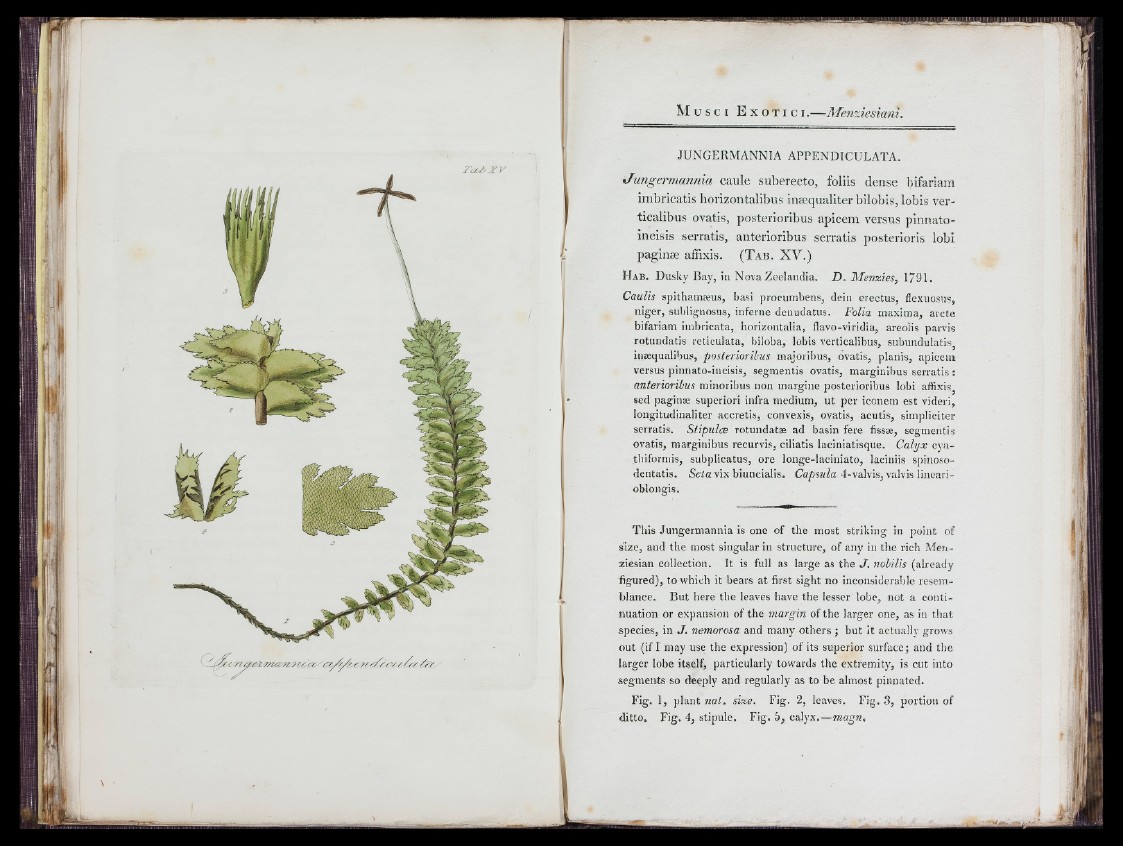
7'adi X V
!I •):
A f
k■ i1':
I i!' ‘i'
nyexl ynccK- ?zy xx' a y l/c r cc c//c v c /cc /re
JUNGERMANNIA APPENDICULATA.
Jungermannia caule suberecto, foliis dense bifariam
imbricatis horizontalibus insequaliter bilobis, lobis verticalibus
ovatis, posterioribus apicem versus pinnato-
incisis serratis, anterioribus serratis posterloris lobi
paglnse affixis. ( T a b . XV.)
H a b . Dusky Bay, in Nova Zeelandia. D . Menzies, 1/91.
Caulis spithamreus, basi procumbens, dein erectus, flexuosus,
niger, sublignosus, inferne denudatus. Folia maxima, arete
bifariam imbricata, horizontaiia, flavo-viridia, areoiis parvis
rotundatis reticulata, biloba, lobis verticalibus, subuiidulati.Sj
inaequalibus, posterioribus majoribus, ovatis, planis, apicem
versus pinnato-incisis, segmentis ovatis, marginibus serratis :
anterioribus minoribus non margine posterioribus lobi affixis^
sed paginae superiori infra medium, ut per iconem est videri,
longitudinaliter accretis, convexis, ovatis, acutis, simpliciter
serratis. StipulcB rotundatae ad basin fere fissae, segmentis
ovatis, marginibus recurvis, ciliatis laciniatisque. Calyx cya-
tbiformis, subplicatus, ore longe-laciniato, laciniis spinoso-
dentatis. Se/a vix biuncialis. Capsula 4-valvis, valvis lineari-
oblongis.
This Jungermannia is one of the most striking in point of
size, and the most singular in structure, of any in the rich Men-
ziesian collection. It is full as large as the J . nobilis (already
figured), to which it bears at first sight no inconsiderable resemblance.
But here the leaves have the lesser lobe, not a continuation
or expansion of the margin of the larger one, as in that
species, in J . nemorosa and many others ; but it actually grows
out ( if f may use the expression) of its superior surface; and the
larger lobe itself, particularly towards the extremity, is cut into
segments so deeply and regularly as to be almost pinnated.
Fig. 1, plant nal. size. Fig. 2, leaves. Fig, 3, portion of
ditto. Fig. 4, stipule. Fig. 5, calyx.—magn.
■ Tl